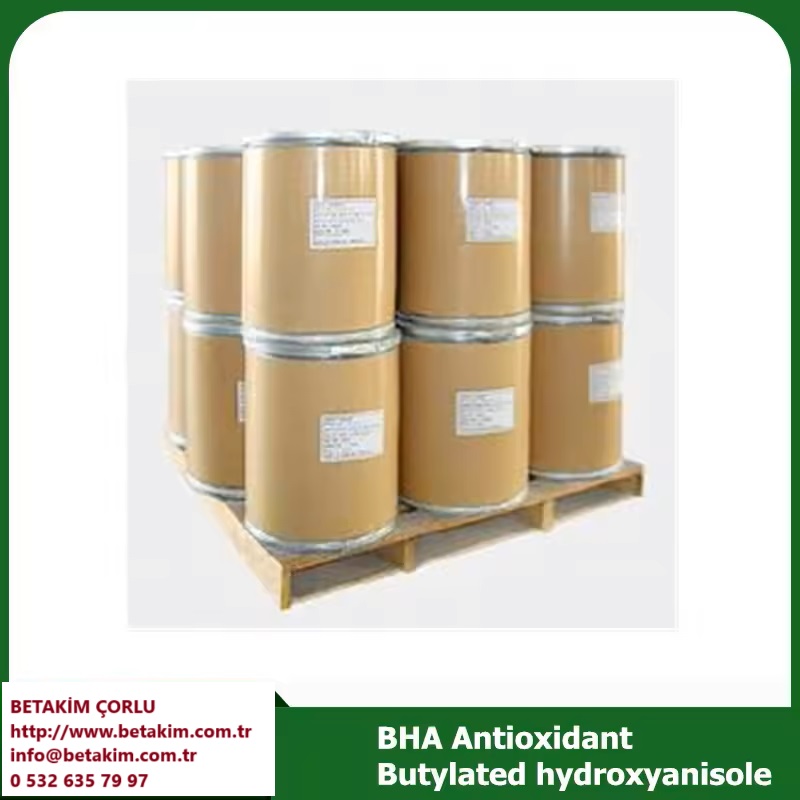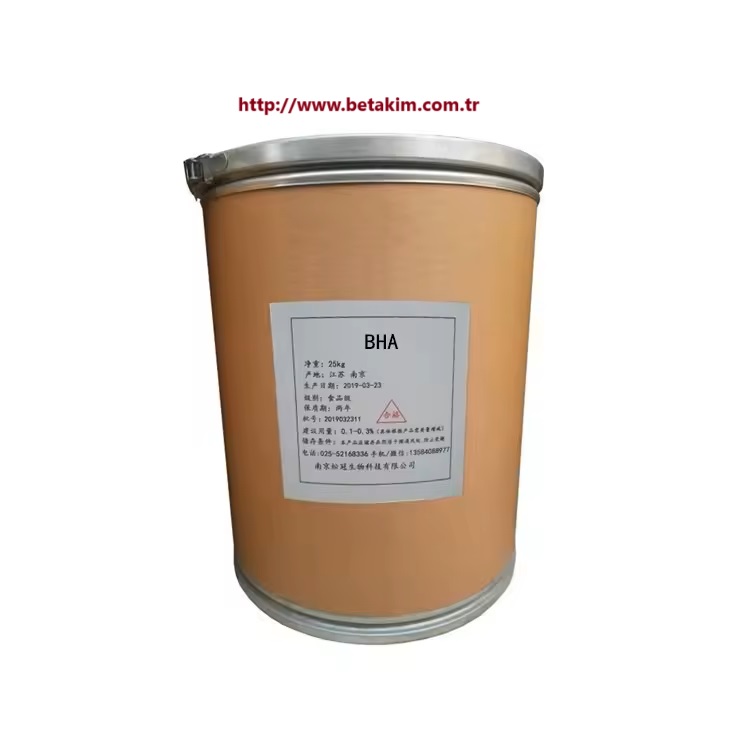We unleash your business potential by maximize the business innovation.
Send EmailE320, Butyl Hydroxy Anisole, BHA, Antioxidant B, Antioxyne B, 25013-16-5
Butylated Hydroxyanisole (BHA), also known as Butil Hidroksi Anisol in Turkish, is a synthetic antioxidant widely used in various industries. Here are some key points about it:
Chemical and Physical Properties
-
Chemical Formula: C₁₁H₁₆O₂
-
Molecular Weight: 180.247 g/mol
-
CAS Number: 25013-16-5
-
Appearance: Waxy solid
-
Solubility: Insoluble in water, but freely soluble in ethanol, methanol, and propylene glycol
Uses
-
Food Industry: Used as a preservative to prevent rancidity in edible fats and fat-containing foods.
-
Cosmetics: Added to cosmetics to prevent oxidation and extend shelf life.
-
Pharmaceuticals: Used in medicines such as vitamin D3, isotretinoin, lovastatin, and simvastatin.
-
Animal Feed: Used as a preservative in animal feed.
-
Rubber and Petroleum Products: Used to prevent oxidation in rubber and petroleum products.
Health Effects
-
Carcinogenicity: The U.S. National Institutes of Health report that BHA is reasonably anticipated to be a human carcinogen based on evidence of carcinogenicity in experimental animals
Butylated Hydroxyanisole (BHA) is known by several other names, including:
-
E320: This is its food additive code.
-
tert-Butyl-4-hydroxyanisole: One of the isomeric forms.
-
2-tert-Butyl-4-hydroxyanisole: Another isomeric form.
-
3-tert-Butyl-4-hydroxyanisole: Yet another isomeric form.
-
(1,1-Dimethylethyl)-4-methoxyphenol: A chemical name.
-
Antioxyne B: Another name used in some contexts.
It has a slightly aromatic odor. It is a chemical compound consisting of a mixture of 2 and 3 tert-butyl-hydroxy-toluene. The mixing ratio here is 90% from 3-tert-butyl-hydroxy-toluene and 10% from 2-tert-butyl-hydroxy-toluene.
It is a synthetic antioxidant. It has the ability to collect free radicals and stabilize free radicals. For this reason, it is also used as a food additive.
It is a monohydric phenolic antioxidant. It is the most effective of all food-approved antioxidants.
Other Names are as follows;
Tert-Butyl-4-Methoxyphenol
Butylhydroxyanisole
Antioxidant B
2-tert-Butyl-4-methoxyphenol
3-tert-Butyl-4-methoxyphenol
Tert-butyl-4-hydroxyanisole
BHA
What are its Physical and Chemical Properties?
Its physical appearance resembles a pale yellow color from white. It is in the form of crystal flakes or crystal powder.
Its melting point is in the range of 58-60 ° C.
The density of BHA is approximately 1.00 g/cm³.
BHA is insoluble in water in terms of solubility. It is soluble in aqueous ethyl alcohol, methyl alcohol, mono propylene glycol, glyceryl mono oleate.
Stability is impaired by prolonged exposure to flammable substances, oxidizing agents and sunlight.
Where are Butyl Hydroxy Anisole (BHA) Used?
It is the most effective antioxidant used to preserve the taste and color of essential oils.
It is used to preserve vitamins A, D, E and K dissolved in oil.
It has a preservative feature in some food applications due to its feature of preventing foods from hardening.
It is used in the production of dry solid particle foods for animals.
It is used to prevent spoilage in the production of animal feeds.
It is used to act as an antioxidant in the production of biodiesel. The use of BHT in this production process also increases the usage performance and fuel quality.
It is used to prevent oxidative degradation of solid and liquid oils.
In the pharmaceutical field, it is used as a preservative in products such as creams, gels, gelatin capsules and tablets.
It is used to protect bio-compounds obtained from some seed oils.



.jpg)